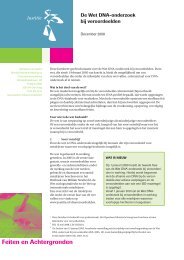INTERPOL HANDBOOK ON DNA DATA EXCHANGE AND PRACTICE
INTERPOL HANDBOOK ON DNA DATA EXCHANGE AND PRACTICE
INTERPOL HANDBOOK ON DNA DATA EXCHANGE AND PRACTICE
You also want an ePaper? Increase the reach of your titles
YUMPU automatically turns print PDFs into web optimized ePapers that Google loves.
APPENDIX 5<strong>DNA</strong> FACT SHEET<strong>DNA</strong> ProfilingDeoxyribonucleic acid (<strong>DNA</strong>) molecules contain the information all living cells in the humanbody need to function. They also control the inheritance of characteristics from parents tooffspring. With the exception of identical twins, each person’s <strong>DNA</strong> is unique, which makes<strong>DNA</strong> sampling useful for solving crimes, identifying victims of disasters, and locating missingpersons.<strong>DNA</strong>’s role in solving crimes<strong>DNA</strong> profiling can play a crucial role in solving crimes, as it has the potential to link a seriesof crimes and/or to place a suspect at the scene of a crime. Just as importantly, <strong>DNA</strong> can helpto prove a suspect’s innocence.The first step in obtaining <strong>DNA</strong> profiles for comparison is the collection of samples fromcrime scenes and reference samples from suspects. Samples are commonly obtained fromblood, hair or body fluids. Advances in <strong>DNA</strong> technology enable samples to be obtained fromdecreasingly smaller traces of <strong>DNA</strong> found at crime scenes. Using forensic science methods,the sample is analysed, resulting in a <strong>DNA</strong> profile that can be compared against other <strong>DNA</strong>profiles within a database. This creates the opportunity for ‘hits’ – scene-to-scene, person-tosceneor person-to-person matches – where no previous connection was known.<strong>INTERPOL</strong>’s <strong>DNA</strong> database<strong>INTERPOL</strong>Police in member countries can submit a <strong>DNA</strong> profile from offenders, crime scenes, missingpersons and unidentified bodies to <strong>INTERPOL</strong>’s automated <strong>DNA</strong> database. Known as the<strong>DNA</strong> Gateway, the database was created in 2002 with a single <strong>DNA</strong> profile but, as of the endof 2008, it contained more than 82,000 <strong>DNA</strong> profiles contributed by 48 member countries.Participating countries are actively using the <strong>DNA</strong> Gateway as a tool in their criminalinvestigations, and it regularly detects potential links between <strong>DNA</strong> profiles submitted bymember countries – searches of the database by member countries led to 27 internationalhits during 2008.Member countries can access the database via the organization’s I-24/7 global policecommunications system and, upon request, access can be extended beyond the membercountries’ National Central Bureaus to forensic centres and laboratories.<strong>INTERPOL</strong> serves only as the conduit for the sharing and comparison of information. It doesnot keep any nominal data linking a <strong>DNA</strong> profile to any individual. A <strong>DNA</strong> profile is simplya list of numbers based on the pattern of an individual’s <strong>DNA</strong>, producing a numerical codewhich can be used to differentiate individuals. This profile does not contain information abouta person’s physical or psychological characteristics, diseases or predisposition for diseases.Member countries that use the <strong>DNA</strong> Gateway retain ownership of their profile data andcontrol its submission, access by other countries and destruction in accordance with theirnational laws.FACT SHEETCOM/FS/2009-08/FS-01PAGE 96 APPENdiX 5dNA FACT SHEET







